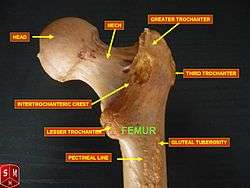Third trochanter
In human anatomy, the third trochanter is a bony projection occasionally present on the proximal femur near the superior border of the gluteal tuberosity. When present, it is oblong, rounded, or conical in shape and sometimes continuous with the gluteal ridge. It generally occurs bilaterally without significant side to side dimorphism. [1] A structure of minor importance in humans, the incidence of the third trochanter varies from 17–72% between ethnic groups and it is frequently reported as more common in females than in males. Structures analogous to the third trochanter are present in other mammals, including some primates. [2] It is called the third trochanter in reference to the greater and lesser trochanters that are always present on the femur.
| Third trochanter | |
|---|---|
 Human femoral bones featuring third trochanters | |
 Human Right Femur. Posterior view, featuring third trochanter | |
| Details | |
| Identifiers | |
| Latin | trochanter tertius |
| TA | A02.5.04.008 |
| FMA | 75824 |
| Anatomical terms of bone | |
Function
Its function is to provide an attachment for the ascending tendon of the gluteus maximus muscle. It may function as (1) a reinforcement mechanism for the proximal femoral diaphysis in response to increased ground reaction force and (2) to increase the attachment surface area for the gluteal musculature and thereby providing greater efficiency of contracture. Mechanical load from the gluteus maximus may, on the other hand, affect the morphology of the proximal femur, similar to how quadriceps determines the size and shape of the tibial tuberosity, and thereby the shape of the third trochanter. [1] However, no certain conclusions regarding the biomechaniccal role of the third trochanter can be made. [3]
Anthropology
The third trochanter is associated with short, robust femora,[1] and is frequently present and well developed in Neanderthals (that were shorter and more robust than anatomically modern humans) but generally absent in higher primates.[2]
Studying fossils of Ardipithecus ramidus (a Chimpanzee-human last common ancestor candidate), Lovejoy et al. 2009 noted that in this species — as well as in Proconsul, Nacholapithecus, and Dryopithecus (Miocene primates) — homologs to the third trochanter and the hypotrochanteric fossa[4] are present while both traits are absent in extant apes. They concluded that the hominid morphotype is primitive and the femoral shape of apes is derived contrary to what was previously thought. [5]
See also
Notes
- Lozanoff, Sciulli & Schneider 1985
- Bolanowski et al. 2005
- Nikolova; et al. (2018). "Trochanter tertius incidence in a Bulgarian population" (PDF). Science & Technologies. 8: 112–115.
- In modern humans, the gluteal tuberosity is occasionally replaced by a shallow groove known as the hypotrochanteric fossa. In some cases, this fossa coexists with the third trochanter.
- Lovejoy et al. 2009
References
- Bolanowski, Wojciech; Śmiszkiewicz-Skwarska, Alicja; Polguj, Michał; Jędrzejewski, Kazimierz S (2005). "The occurrence of the third trochanter and its correlation to certain anthropometric parameters of the human femur" (PDF). Folia Morphol. 64 (3): 168–175.CS1 maint: ref=harv (link)
- Lovejoy, C Owen; Suwa, Gen; Spurlock, Linda; Asfaw, Berhane; White, Tim D (October 2009). "The Pelvis and Femur of Ardipithecus ramidus: The Emergence of Upright Walking" (PDF). Science. 326 (5949): 71, 71e1–71e6. doi:10.1126/science.1175831.CS1 maint: ref=harv (link)
- Lozanoff, Scott; Sciulli, Paul W; Schneider, Kim N (December 1985). "Third trochanter incidence and metric trait covariation in the human femur". J Anat. 143 (143): 149–159. PMC 1166433. PMID 3870721.CS1 maint: ref=harv (link)